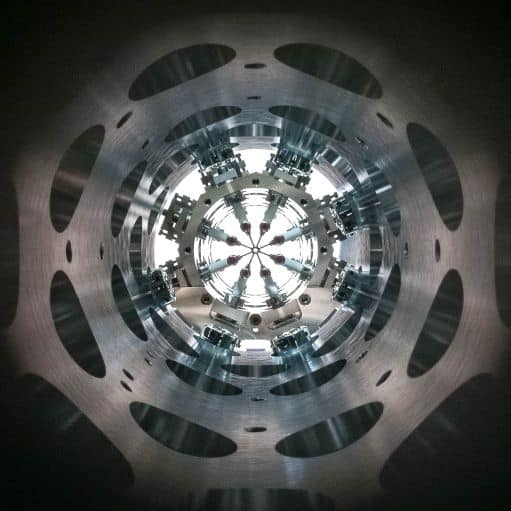Laser-free trapping of heavy molecules opens an alternative route to new physics
14 Nov 2021
The quest for physics outside the Standard Model often takes place at major accelerator facilities like CERN’s Large Hadron Collider or huge underground detectors for neutrinos, dark matter and other exotic particles. Researchers in the Netherlands have now opened an alternative front in this quest by developing a new laboratory-scale technique for trapping heavy neutral molecules. Such molecules are considered ideal candidates for detecting beyond-the-Standard-Model asymmetries in the electron’s electric dipole moment (eEDM), but previous methods were not capable of confining them. The technique therefore gives physicists a fresh set of tools for finding new physics.
Standard methods used in eEDM searches involve performing high-precision spectroscopy on atoms or molecules that are first slowed and then trapped with lasers or electric fields for the duration of the measurement. The problem is that finding new physics may require trapping molecules that are too heavy to be confined with lasers. Electric fields, for their part, can only trap heavy ions, rather than neutral atoms or molecules.
It’s a trap!
A new method can now be added to this list thanks to researchers at the University of Groningen, who developed it in collaboration with colleagues at Vrije Universiteit Amsterdam and Nikhef, the Dutch particle-physics institute. The researchers begin by creating molecules of strontium fluoride (SrF) via a chemical reaction that takes place inside a cryogenic gas at a temperature of around 20 K. These molecules have initial velocities of 190 m/s, compared to around 500 m/s at room temperature.
The molecules then enter a 4.5-metre-long device called a Stark decelerator in which alternating electric fields act to slow and then stop them. The SrF molecules remain trapped for 50 ms, after which the researchers analyse them using a separate laser-induced fluorescence detection system. Such measurements reveal fundamental properties of the electron, including the eEDM, that can then be checked for any asymmetry.
The heavier the better
These SrF molecules are around three times heavier than other molecules previously trapped using similar techniques, notes Steven Hoekstra, a physicist at Groningen and lead investigator on the research. “Our next step is to trap even heavier molecules, such as barium fluoride (BaF), which is one-and-a-half times heavier than SrF,” he says. “This type of molecule is even better for measurements on the electron dipole. Basically, the heavier [the molecule], the better these measurements will become.” Molecular decelerators: members of the NL-eEDM team. (Courtesy: Steven Hoekstra)
Molecular decelerators: members of the NL-eEDM team. (Courtesy: Steven Hoekstra)
 Molecular decelerators: members of the NL-eEDM team. (Courtesy: Steven Hoekstra)
Molecular decelerators: members of the NL-eEDM team. (Courtesy: Steven Hoekstra)Trapping heavy molecules has other applications beyond eEDM measurements. One example might be to study collisions between molecules at low energies, under conditions similar to those found in space. Measurements on slowly moving molecules could also yield deeper insights into the quantum nature of their interactions. At high enough densities, the molecules’ so-called dipole–dipole interaction, which depends on their orientation relative to each other, makes a big difference in how they interact. These types of measurements offer opportunities that are not possible with stationary atoms, which do not interact in this way.
Complex and chiral
As a next step, Hoekstra says that he and his colleagues, who report their work in Physical Review Letters, plan to increase the sensitivity of their measurement setup by upping the intensity of their molecular beam. “We are also thinking of trapping more complex molecules, such as BaOH or BaOCH3,” he tells Physics World. “Additionally, we could use our technique to study asymmetries within chiral molecules: those that have a left and right-handed version.”READ MORE

Ben Sauer, a physicist at Imperial College in the UK who was not involved in the current study, describes the result as the culmination of about 20 years of research on molecule deceleration. He predicts that it will have a big impact on precision measurements of the eEDM, where the resolution of the measurement is directly proportional to the time available to interrogate the molecules. As for wider applications, Sauer says: “I can see it being applied to some special cases. I think the limit is that there is a lot more interest in light molecules than heavy ones, since most of chemistry takes place at the top of the periodic table. But it is really good for physics investigations.”
Martijn Boerkamp is a science journalist based in the Netherlands
from physicsworld.com 17/12/2021

Δεν υπάρχουν σχόλια:
Δημοσίευση σχολίου